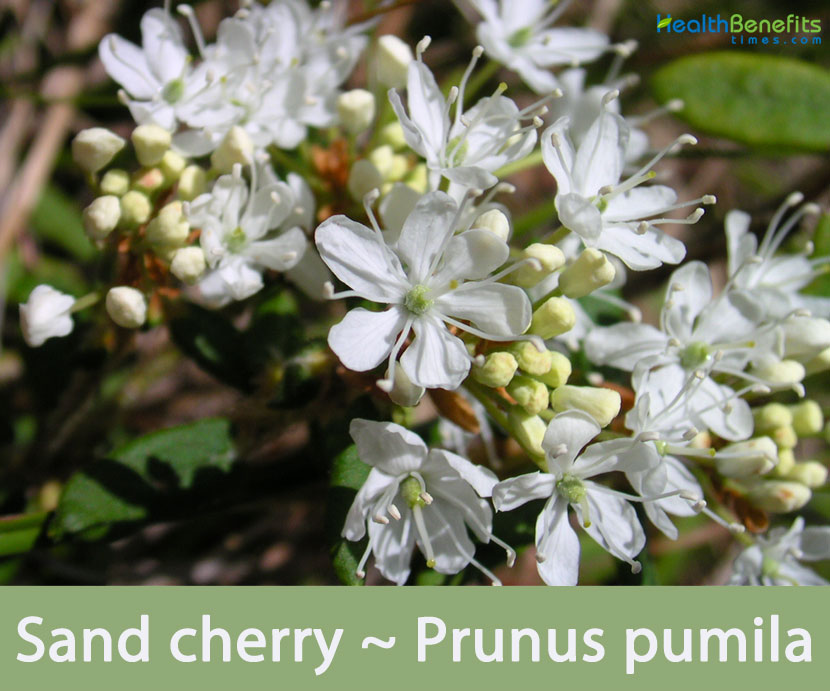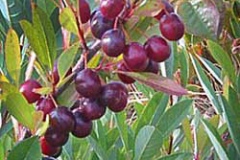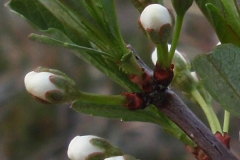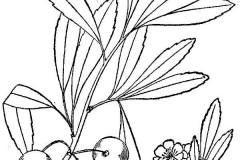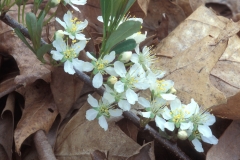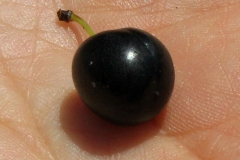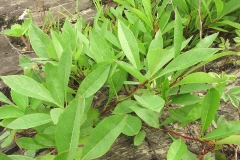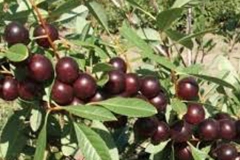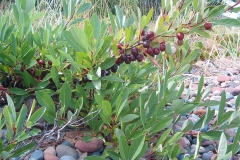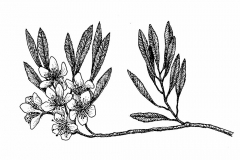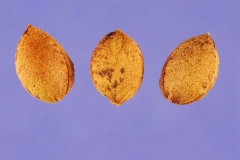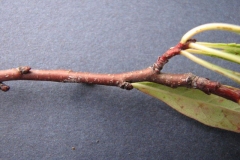| Sand cherry Quick Facts | |
|---|---|
| Name: | Sand cherry |
| Scientific Name: | Prunus pumila |
| Origin | Eastern and central Canada from New Brunswick west to Saskatchewan |
| Colors | Reddish purple ripening to dark purple or nearly black |
| Shapes | Small shiny globose cherry 13–15 millimeters (0.51–0.59 in) in diameter |
| Taste | Pleasantly acid taste when fully ripe |
| Name | Sand cherry |
|---|---|
| Scientific Name | Prunus pumila |
| Native | Eastern and central Canada from New Brunswick west to Saskatchewan and the northern United States from Maine to Montana, south as far as Colorado, Kansas, Indiana, and Virginia, with a few isolated populations in Tennessee and Utah |
| Common Names | Dwarf American Cherry, Sand cherry, Western sand cherry, Eastern sand cherry, Great Lakes sand cherry, Sesquehana sand cherry |
| Name in Other Languages | Azerbaijani: Bessey albalısı Dutch: Zandkers English: Sand cherry, Dwarf cherry, dwarf American cherry Finnish: Hietakirsikka French: Cerisier du Canada, Cerisier canadien, Cerisier des sables, Cerisier nain, Ragouminier German: Kanadischer Kirsche, Kanadischer Kirschbaum, Niedriger kanadischer kirschbaum, Sand-Kirsche, Kirschbaum, Kanadischer Sand, kanadischer Sandkirschbaum Italy: Ciliegio del Canada Persian: پرونوس پومیلا Polish: Wisnia drobna Russian: Sliva karlikovaya (Слива карликовая) Spanish: Cerezo del Canada Swedish: Sandkörsbär |
| Plant Growth Habit | Unarmed, diffusely branched, low growing, deciduous shrub |
| Growing Climates | Sand dunes, calcareous rocky shores, beaches, outwash plains, cliffs, balds, or ledges, shores of rivers or lakes, talus and rocky slopes, interdunal flats, in both Upper Peninsula and Lower Peninsula, rocky ledges, pavements, and summits |
| Soil | Requires a well-drained moisture retentive soil. The plant grows in the wild on sandy, gravelly, and rocky soils, dunes, beaches, and outwash plains – sites are typically dry and excessively drained. Thrives in a loamy soil, doing well on limestone. Prefers some chalk in the soil but apt to become chlorotic if too much is present |
| Plant Size | Grows to 2-6 feet tall depending on the variety |
| Stem | Usually erect-ascending, sometimes decumbent. Older stems develop a grayish, glabrous bark, while younger twigs are often tannish- to reddish-brown or brown. |
| Twigs | Red to reddish brown, shiny smooth developing a flaky, waxy cuticle |
| Bark | Grayish brown, smooth becoming roughish with conspicuous horizontal pores |
| Leaf | Simple, leathery and alternate, 4–7 centimeters (1.6–2.8 in) long and up to 2-3 centimeters (1 inch) wide |
| Flowering season | May |
| Flower | Flowers are 15–25 millimeters (0.59–0.98 in) in diameter with five white petals and 25–30 stamens. They are produced in small clusters of two to four. |
| Fruit Shape & Size | Small shiny globose cherry 13–15 millimeters (0.51–0.59 in) in diameter |
| Fruit Color | Reddish purple ripening to dark purple or nearly black |
| Propagation | Semi-ripe cuttings |
| Taste | Pleasantly acid taste when fully ripe though they are sometimes slightly bitter |
| Lifespan | More than a year |
| Season | Late July and early August |
| Traditional health Benefits |
|
Twigs
Twigs are red to reddish brown, shiny smooth developing a flaky, waxy cuticle. Branches are spreading to ascending from low, sprawling basal stems. Bark is grayish brown, smooth becoming roughish with conspicuous horizontal pores (lenticels). Basal stems are about ¾ inch diameter.
Leaves
Leaves are simple, leathery and alternate, 4–7 centimeters (1.6–2.8 in) long and up to 2-3 centimeters (1 inch) wide. The blade is narrowly elliptic or widest near the tip (obovate) depending on the variety, with a pointed tip and tapering at the base to a ¼ to ½ inch stalk. The upper surface is dark green and somewhat shiny, the lower surface lighter and smooth. Edges are finely toothed except near the base.
Flowers
Numerous flat to convex clusters from lateral buds along the branches, each cluster a 1 to 3-flowered umbel (stalks all arising from the same point) and emerging before the leaves in spring. Flowers are about ½ inch across with 5 white, round to egg-shaped petals with a single slender style and a spray of slender, white, yellow-tipped stamens in the center. The 5 sepals are about 1/3 the length of the petals, lance-oblong, rounded at the tip, spreading, with several small glands along the edges near the tip. Inner and outer surfaces are smooth. Flower stalks are slender and hairless.
Fruit
Fertile flowers are followed by a small shiny globose cherry 13–15 millimeters (0.51–0.59 in) in diameter. It is reddish purple ripening to dark purple or nearly black in early summer. Each fruit consists of a single hard seed inside.
Culinary Uses
- Fruit can be consumed raw or cooked.
- Seed can be consumed raw or cooked.
- Do not eat the seed if it is too bitter.
- It can be eaten out of hand, used in preserves or dried for later use.
Other Facts
- Green dye can be obtained from the leaves.
- Dark grey to green dye can be obtained from the fruit.
- It is used as a rootstock for the sour cherry.
- Leaves can even provide fodder for livestock.
- It is an excellent soil stabilizer and is used on dunes, roadside plantings etc.
- It is also used as a rootstock and in breeding programs, especially with the Japanese plum.
- It is a good dwarfing rootstock for peaches, apricots and plums.
Precautions
- In excess, however, it can cause respiratory failure and even death.
- In larger concentrations, however, cyanide can cause gasping, weakness, excitement, pupil dilation, spasms, convulsions, coma and respiratory failure leading to death.
- Some species’ leaves and fruits are poisonous to humans and can cause serious stomach pain when ingested.
References:
https://www.itis.gov/servlet/SingleRpt/SingleRpt?search_topic=TSN&search_value=504625#null
https://pfaf.org/user/Plant.aspx?LatinName=Prunus+pumila
https://www.cabi.org/isc/datasheet/44333
https://en.wikipedia.org/wiki/Prunus_pumila
https://plants.usda.gov/core/profile?symbol=PRPU3
https://gobotany.nativeplanttrust.org/species/prunus/pumila/
https://www.minnesotawildflowers.info/shrub/sand-cherry
http://temperate.theferns.info/viewtropical.php?id=Prunus+pumila
https://gd.eppo.int/taxon/PRNPU
https://www.nrc.gov/docs/ML0707/ML070730114.pdf
http://tn-grin.nat.tn/gringlobal/taxonomydetail.aspx?id=30083
http://www.theplantlist.org/tpl1.1/record/rjp-5914
https://davesgarden.com/guides/pf/go/59471/#b
http://www.kansasnativeplants.com/guide/plant_detail.php?plnt_id=776


